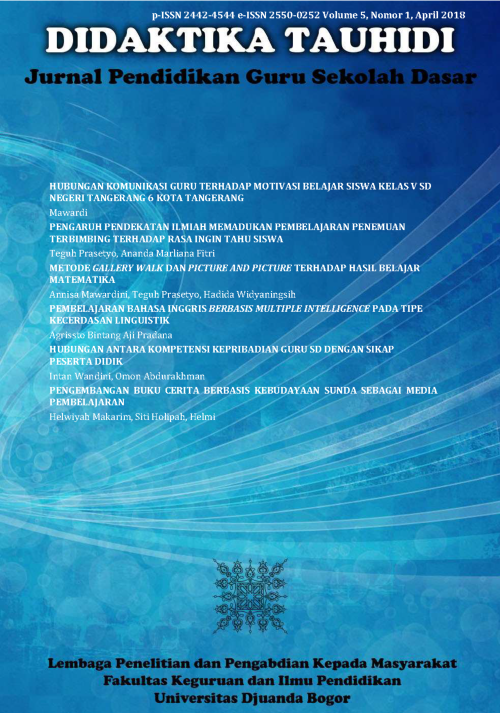ENGLISH LEARNING BASED ON MULTIPLE INTELLIGENCE IN TYPE OF LINGUISTIC INTELLIGENCE
Main Article Content
Abstract
This study aims to describe the application of English language learning based on Multiple Intelligence Theory on the type of linguistic intelligence and student responses in following the learning of English. This research is a descriptive research, conducted in Madrasah Ibtidaiyah Muhammadiyah Special Program Kartasura. Respondents in this study were principals, English language teachers, and 34 students. Data were collected through interview (semi-structured interview), observation, and questionnaire. Data were analyzed by step (1) data reduction; (2) data display; (3) verification. The results revealed that the students as a whole showed a positive response to the learning activities. As many as 88.2% of students have motivation to participate in learning activities, 82% interested in the material, and 79% like English subjects. In conclusion that students showed high intensity of physical motion almost resembles the characteristics of students with kinesthetic and naturalistic types and apply different concepts.
Article Details
1. PROPOSED POLICY FOR JOURNALS THAT OFFER OPEN ACCESS
Authors who publish with this journal agree to the following terms:
- Authors retain copyright and grant the journal right of first publication with the work simultaneously licensed under a Creative Commons Attribution License that allows others to share the work with an acknowledgement of the work's authorship and initial publication in this journal.
- Authors are able to enter into separate, additional contractual arrangements for the non-exclusive distribution of the journal's published version of the work (e.g., post it to an institutional repository or publish it in a book), with an acknowledgement of its initial publication in this journal.
- Authors are permitted and encouraged to post their work online (e.g., in institutional repositories or on their website) prior to and during the submission process, as it can lead to productive exchanges, as well as earlier and greater citation of published work (See The Effect of Open Access).
2. PROPOSED POLICY FOR JOURNALS THAT OFFER DELAYED OPEN ACCESS
Authors who publish with this journal agree to the following terms:
- Authors retain copyright and grant the journal right of first publication, with the work [SPECIFY PERIOD OF TIME] after publication simultaneously licensed under a Creative Commons Attribution License that allows others to share the work with an acknowledgement of the work's authorship and initial publication in this journal.
- Authors are able to enter into separate, additional contractual arrangements for the non-exclusive distribution of the journal's published version of the work (e.g., post it to an institutional repository or publish it in a book), with an acknowledgement of its initial publication in this journal.
- Authors are permitted and encouraged to post their work online (e.g., in institutional repositories or on their website) prior to and during the submission process, as it can lead to productive exchanges, as well as earlier and greater citation of published work (See The Effect of Open Access).

References
Ahmad, A. R., Seman, A. A., Awang, M. M., & Sulaiman, F. (2014). Application of Multiple Intelligence Theory to Increase Student Motivation in Learning History. Asian Culture and History, 7(1), 210–219. https://doi.org/10.5539/ach.v7n1p210
Armstrong, T. (2003). The Multiple Intelligences of Reading and Writing (Vol. 5). Alexandria: Association for Supervision and Curriculum Development.
Atta, M. A., & Jamil, A. (2012). Effects of motivation and parental influence on the educational attainments of students at secondary level. Academic Research International, 2(3), 427–431. Retrieved from http://www.savap.org.pk/journals/ARInt./Vol.2(3)/2012(2.3-52).pdf
Basheer Nomass, B. (2013). The Impact of Using Technology in Teaching English as a Second Language. English Language and Literature Studies, 3(1), 111–116. https://doi.org/10.5539/ells.v3n1p111
Demirci Assoc, C. (2017). The Effect of Active Learning Approach on Attitudes of 7 th Grade Students. International Journal of Instruction, 10(104), 129–144. https://doi.org/10.12973/iji.2017.1048a
Derakhshan, A., & Faribi, M. (2015). Multiple Intelligences: Language Learning and Teaching. International Journal of English Linguistics, 5(4), 63–72. https://doi.org/10.5539/ijel.v5n4p63
Fayazi-Nasab, E., & Ghafournia, N. (2016). The Relationship between Multiple Intelligences and Motivational Strategies. English Linguistics Research, 5(2), 20–27. https://doi.org/10.5430/elr.v5n2p20
Gardner, H. (1985). Frames of Mind: The Theory of Multiple Intelligences. New York: Basic Books.
Gardner, H. (1993). Multiple Intelligences: The Theory in Practice. A Reader. New York: Basic Books.
Gardner, H. (1999). Intelligence Reframe. New York: Basic Books.
Hajhashemi, K., Ghombavani, F., & Amirkhiz, S. (2011). The Relationship between Iranian EFL High School Students’ Multiple Intelligence Scores and their Use of Learning Strategies. English Language Teaching, 4(3), 214–222. https://doi.org/10.5539/elt.v4n3p214
Hanh, L. T. T., & Tien, T. B. (2017). Multiple Intelligences-Based Homework and EFL Students’ Vocabulary Learning. International Journal of English Linguistics, 7(6), 73. https://doi.org/10.5539/ijel.v7n6p73
Madkour, M., & Mohamed, R. A. A. M. (2016). Identifying College Students’ Multiple Intelligences to Enhance Motivation and Language Proficiency. English Language Teaching, 9(6), 92. https://doi.org/10.5539/elt.v9n6p92
Maria Abdullah, G. J. (2004). Promoting Cooperative Learning at Primary School. The Electronic Journal for English as a Second Language. Retrieved from http://www.tesl-ej.org/wordpress/issues/volume7/ej28/ej28a1/
Miles, M., & Huberman, A. M. (1994). Qualitative Data Analysis : An Expanded Sourcebook (2nd ed.). Thousand Oaks: Sage Publications.
Rahimi, M., Sadighi, F., & Hosseiny Fard, Z. (2012). The impact of linguistic and emotional intelligence on the reading performance of Iranian EFL learners. Journal of Teaching Language Skills, 30(1), 151–171.
Shakouri, N., Sheikhy Behdani, R., & Teimourtash, M. (2016). On the relationship between linguistic intelligence and recalling lexical items in SLA. International Journal of Research Studies in Education, 6(4). https://doi.org/10.5861/ijrse.2016.1644
Sulaiman, S., & Sulaiman, T. (2010). Enhancing Language Teaching and Learning by Keeping Individual Differences in Perspective. International Education Studies, 3(2), p134. https://doi.org/10.5539/ies.v3n2p134
Tirri, K., & Nokelainen, P. (2012). Measuring Multiple Intelligences and Moral Sensitivities in Education. https://doi.org/10.1007/s13398-014-0173-7.2
Uysal, N. D., & Yavuz, F. (2015). Teaching English to Very Young Learners. Procedia - Social and Behavioral Sciences, 197(February), 19–22. https://doi.org/10.1016/j.sbspro.2015.07.042
Vakili, L. (2013). The Relationship between Linguistic Intelligence and L2 Learning Strategies among EFL Learners with Intermediate Level of Proficiency, 1, 89–93.
Younas, M., Subhani, A., & Akram, H. (2015). English Language Learning : A Role of Multiple Intelligence. English for Specific Purposes World, (46).

